 Backend Development
Backend Development
 Python Tutorial
Python Tutorial
 Detailed explanation of 16 Pandas functions to improve your 'data cleaning' ability by 100 times!
Detailed explanation of 16 Pandas functions to improve your 'data cleaning' ability by 100 times!
Detailed explanation of 16 Pandas functions to improve your 'data cleaning' ability by 100 times!
Introduction to this article


1 data set, 16 Pandas functions
import pandas as pd
df ={'姓名':[' 黄同学','黄至尊','黄老邪 ','陈大美','孙尚香'],
'英文名':['Huang tong_xue','huang zhi_zun','Huang Lao_xie','Chen Da_mei','sun shang_xiang'],
'性别':['男','women','men','女','男'],
'身份证':['463895200003128433','429475199912122345','420934199110102311','431085200005230122','420953199509082345'],
'身高':['mid:175_good','low:165_bad','low:159_bad','high:180_verygood','low:172_bad'],
'家庭住址':['湖北广水','河南信阳','广西桂林','湖北孝感','广东广州'],
'电话号码':['13434813546','19748672895','16728613064','14561586431','19384683910'],
'收入':['1.1万','8.5千','0.9万','6.5千','2.0万']}
df = pd.DataFrame(df)
df
① cat函数:用于字符串的拼接
df["姓名"].str.cat(df["家庭住址"],sep='-'*3)
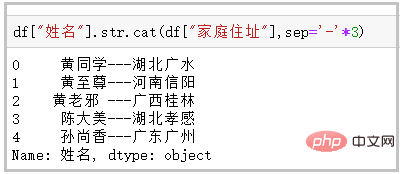
② contains:判断某个字符串是否包含给定字符
df["家庭住址"].str.contains("广")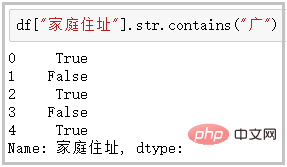
③ startswith/endswith:判断某个字符串是否以…开头/结尾
# 第一个行的“ 黄伟”是以空格开头的
df["姓名"].str.startswith("黄")
df["英文名"].str.endswith("e")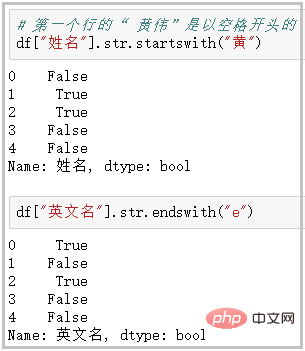
④ count:计算给定字符在字符串中出现的次数
df["电话号码"].str.count("3")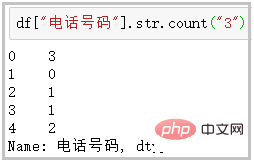
⑤ get:获取指定位置的字符串
df["姓名"].str.get(-1)
df["身高"].str.split(":")
df["身高"].str.split(":").str.get(0)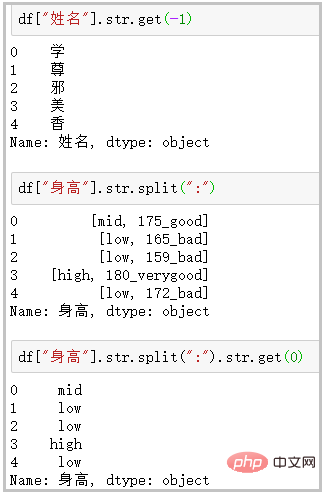
⑥ len:计算字符串长度
df["性别"].str.len()
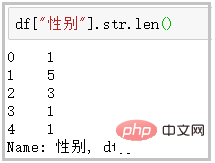
⑦ upper/lower:英文大小写转换
df["英文名"].str.upper() df["英文名"].str.lower()
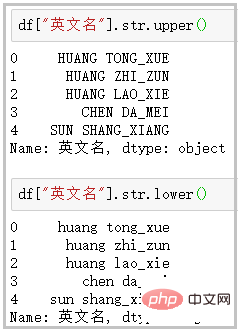
⑧ pad+side参数/center:在字符串的左边、右边或左右两边添加给定字符
df["家庭住址"].str.pad(10,fillchar="*") # 相当于ljust() df["家庭住址"].str.pad(10,side="right",fillchar="*") # 相当于rjust() df["家庭住址"].str.center(10,fillchar="*")
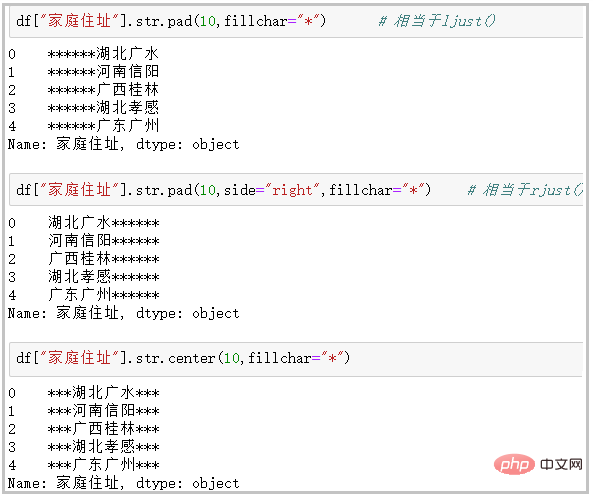
⑨ repeat:重复字符串几次
df["性别"].str.repeat(3)
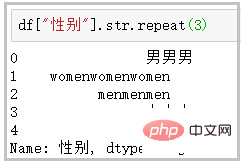
⑩ slice_replace:使用给定的字符串,替换指定的位置的字符
df["电话号码"].str.slice_replace(4,8,"*"*4)
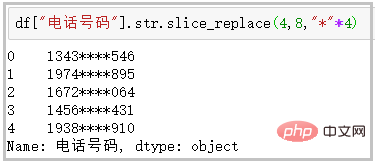
⑪ replace:将指定位置的字符,替换为给定的字符串
df["身高"].str.replace(":","-")
⑫ replace:将指定位置的字符,替换为给定的字符串(接受正则表达式)
replace中传入正则表达式,才叫好用; 先不要管下面这个案例有没有用,你只需要知道,使用正则做数据清洗多好用;
df["收入"].str.replace("\d+\.\d+","正则")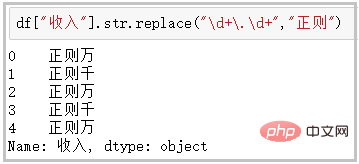
⑬ split方法+expand参数:搭配join方法功能很强大
# 普通用法
df["身高"].str.split(":")
# split方法,搭配expand参数
df[["身高描述","final身高"]] = df["身高"].str.split(":",expand=True)
df
# split方法搭配join方法
df["身高"].str.split(":").str.join("?"*5)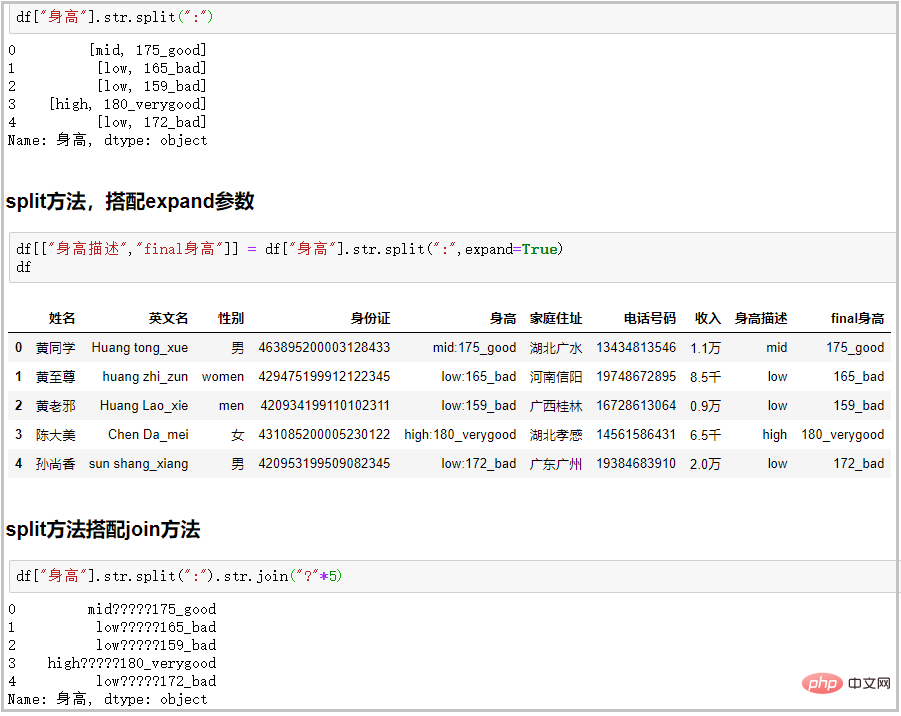
⑭ strip/rstrip/lstrip:去除空白符、换行符
df["姓名"].str.len() df["姓名"] = df["姓名"].str.strip() df["姓名"].str.len()
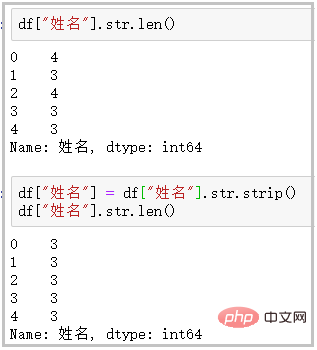
⑮ findall:利用正则表达式,去字符串中匹配,返回查找结果的列表
findall使用正则表达式,做数据清洗,真的很香!
df["身高"]
df["身高"].str.findall("[a-zA-Z]+")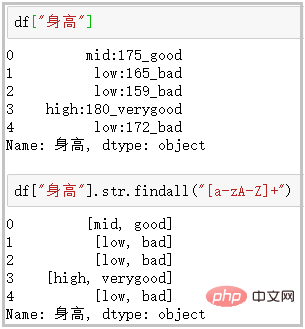
⑯ extract/extractall:接受正则表达式,抽取匹配的字符串(一定要加上括号)
df["身高"].str.extract("([a-zA-Z]+)")
# extractall提取得到复合索引
df["身高"].str.extractall("([a-zA-Z]+)")
# extract搭配expand参数
df["身高"].str.extract("([a-zA-Z]+).*?([a-zA-Z]+)",expand=True)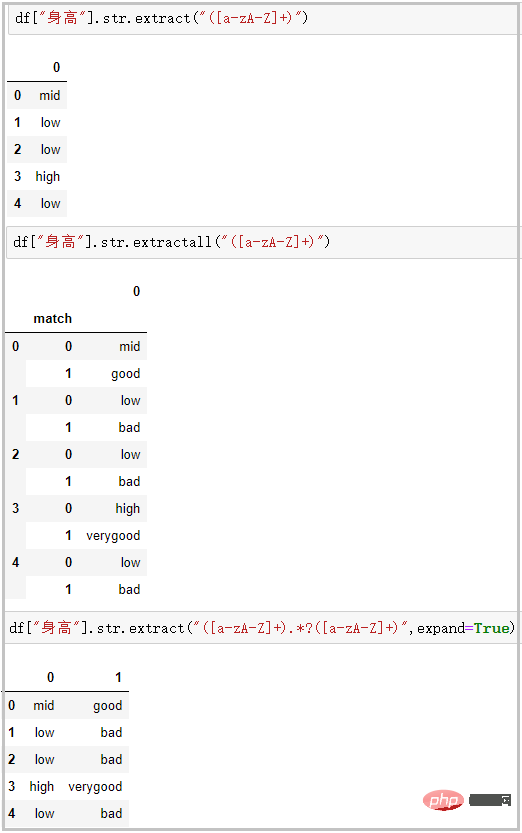
The above is the detailed content of Detailed explanation of 16 Pandas functions to improve your 'data cleaning' ability by 100 times!. For more information, please follow other related articles on the PHP Chinese website!

Hot AI Tools

Undresser.AI Undress
AI-powered app for creating realistic nude photos

AI Clothes Remover
Online AI tool for removing clothes from photos.

Undress AI Tool
Undress images for free

Clothoff.io
AI clothes remover

Video Face Swap
Swap faces in any video effortlessly with our completely free AI face swap tool!

Hot Article

Hot Tools

Notepad++7.3.1
Easy-to-use and free code editor

SublimeText3 Chinese version
Chinese version, very easy to use

Zend Studio 13.0.1
Powerful PHP integrated development environment

Dreamweaver CS6
Visual web development tools

SublimeText3 Mac version
God-level code editing software (SublimeText3)

Hot Topics
 1664
1664
 14
14
 1423
1423
 52
52
 1318
1318
 25
25
 1269
1269
 29
29
 1248
1248
 24
24
 PHP and Python: Different Paradigms Explained
Apr 18, 2025 am 12:26 AM
PHP and Python: Different Paradigms Explained
Apr 18, 2025 am 12:26 AM
PHP is mainly procedural programming, but also supports object-oriented programming (OOP); Python supports a variety of paradigms, including OOP, functional and procedural programming. PHP is suitable for web development, and Python is suitable for a variety of applications such as data analysis and machine learning.
 Choosing Between PHP and Python: A Guide
Apr 18, 2025 am 12:24 AM
Choosing Between PHP and Python: A Guide
Apr 18, 2025 am 12:24 AM
PHP is suitable for web development and rapid prototyping, and Python is suitable for data science and machine learning. 1.PHP is used for dynamic web development, with simple syntax and suitable for rapid development. 2. Python has concise syntax, is suitable for multiple fields, and has a strong library ecosystem.
 How to run sublime code python
Apr 16, 2025 am 08:48 AM
How to run sublime code python
Apr 16, 2025 am 08:48 AM
To run Python code in Sublime Text, you need to install the Python plug-in first, then create a .py file and write the code, and finally press Ctrl B to run the code, and the output will be displayed in the console.
 PHP and Python: A Deep Dive into Their History
Apr 18, 2025 am 12:25 AM
PHP and Python: A Deep Dive into Their History
Apr 18, 2025 am 12:25 AM
PHP originated in 1994 and was developed by RasmusLerdorf. It was originally used to track website visitors and gradually evolved into a server-side scripting language and was widely used in web development. Python was developed by Guidovan Rossum in the late 1980s and was first released in 1991. It emphasizes code readability and simplicity, and is suitable for scientific computing, data analysis and other fields.
 Python vs. JavaScript: The Learning Curve and Ease of Use
Apr 16, 2025 am 12:12 AM
Python vs. JavaScript: The Learning Curve and Ease of Use
Apr 16, 2025 am 12:12 AM
Python is more suitable for beginners, with a smooth learning curve and concise syntax; JavaScript is suitable for front-end development, with a steep learning curve and flexible syntax. 1. Python syntax is intuitive and suitable for data science and back-end development. 2. JavaScript is flexible and widely used in front-end and server-side programming.
 Golang vs. Python: Performance and Scalability
Apr 19, 2025 am 12:18 AM
Golang vs. Python: Performance and Scalability
Apr 19, 2025 am 12:18 AM
Golang is better than Python in terms of performance and scalability. 1) Golang's compilation-type characteristics and efficient concurrency model make it perform well in high concurrency scenarios. 2) Python, as an interpreted language, executes slowly, but can optimize performance through tools such as Cython.
 Where to write code in vscode
Apr 15, 2025 pm 09:54 PM
Where to write code in vscode
Apr 15, 2025 pm 09:54 PM
Writing code in Visual Studio Code (VSCode) is simple and easy to use. Just install VSCode, create a project, select a language, create a file, write code, save and run it. The advantages of VSCode include cross-platform, free and open source, powerful features, rich extensions, and lightweight and fast.
 How to run python with notepad
Apr 16, 2025 pm 07:33 PM
How to run python with notepad
Apr 16, 2025 pm 07:33 PM
Running Python code in Notepad requires the Python executable and NppExec plug-in to be installed. After installing Python and adding PATH to it, configure the command "python" and the parameter "{CURRENT_DIRECTORY}{FILE_NAME}" in the NppExec plug-in to run Python code in Notepad through the shortcut key "F6".



